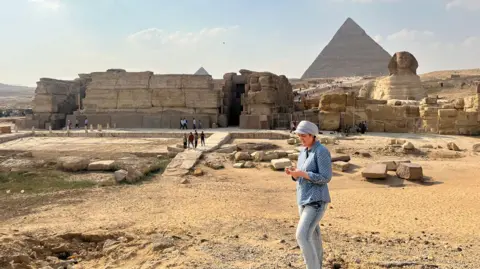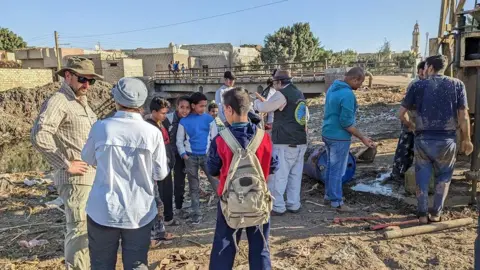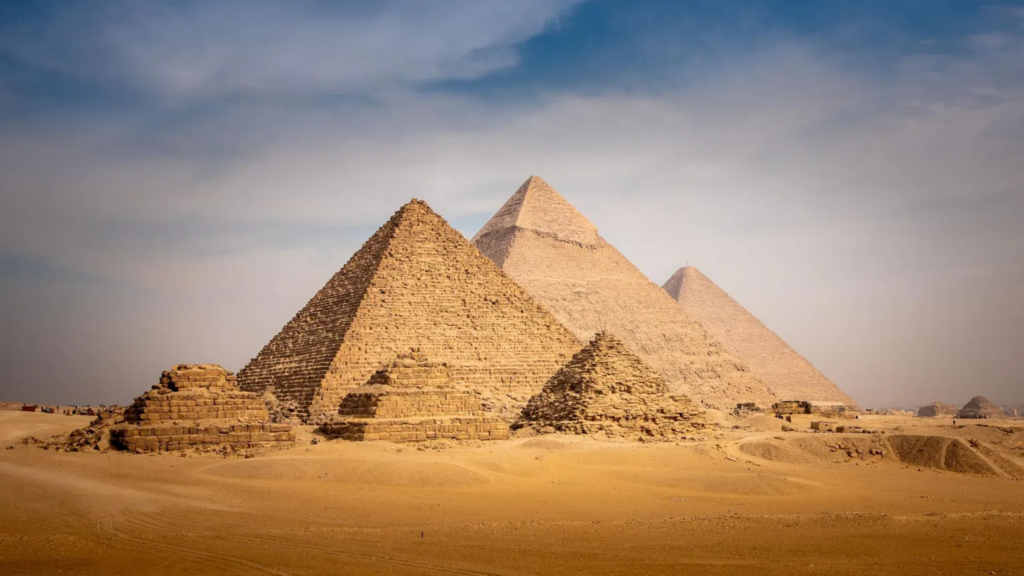Scientists believe they may have solved the mystery of how 31 pyramids, including the world-famous Giza complex, were built in Egypt more than 4,000 years ago.
A research team from the University of North Carolina Wilmington has discovered that the pyramids are likely to have been built along a long-lost, ancient branch of the River Nile - which is now hidden under desert and farmland.
For many years, archaeologists have thought that ancient Egyptians must have used a nearby waterway to transport materials such as the stone blocks needed to build the pyramids on the river.
But up until now, "nobody was certain of the location, the shape, the size or proximity of this mega waterway to the actual pyramids site", according to one of the study's authors, Prof Eman Ghoneim.

In a cross-continental effort, the group of researchers used radar satellite imagery, historical maps, geophysical surveys, and sediment coring (a technique used by archaeologists to recover evidence from samples) to map the river branch - which they believe was buried by a major drought and sandstorms thousands of years ago.
The team were able to "penetrate the sand surface and produce images of hidden features" by using the radar technology, the study, published in the journal Nature, said.
Among those features were "buried rivers and ancient structures" running at the foothills of where the "vast majority of the Ancient Egyptian pyramids lie," Prof Ghoneim said.

Speaking to the BBC, one of the study's co-authors, Dr Suzanne Onstine, said, "locating the actual [river] branch and having the data that shows there was a waterway that could be used for the transportation of heavier blocks, equipment, people, everything, really helps us explain pyramid construction."
The team found that the river branch - named the Ahramat branch, with "ahramat" meaning pyramids in Arabic - was roughly 64km (39 miles) long and between 200-700m (656-2,296 ft)wide.
And it bordered 31 pyramids, which were built between 4,700 and 3,700 years ago.

The discovery of this extinct river branch helps explain the high pyramid density between Giza and Lisht (the site of Middle Kingdom burials), in what is now an inhospitable area of the Saharan desert.
The river branch's proximity to the pyramid complexes suggests that it was "active and operational during the construction phase of these pyramids", the paper said.
Dr Onstine explained that ancient Egyptians could "use the river's energy to carry these heavy blocks, rather than human labour," adding, "it's just a lot less effort".
The River Nile was the lifeline of Ancient Egypt - and remains so to this day.
Latest Stories
-
I almost shut down Ghana’s internet over tragic helicopter crash videos – Sam George
7 minutes -
Bawumia secures support of over 490 youth organisers before 2026 NPP flagbearer contest
10 minutes -
Volta NDC chairman calls for national reflection at vigil honouring helicopter crash victims
12 minutes -
Paul Afoko mourns with Asante Kingdom after passing of Asantehemaa
20 minutes -
Helicopter crash: ‘We can’t fault GAF for arriving late’ — Col. Aboagye
33 minutes -
Dutch-Ghanaian winger Ernest Poku joins Bayer Leverkusen on five-year deal
39 minutes -
Bellview International School CEO pleads with parents over poor quality time
50 minutes -
A conversation with my comrade – the poor are not to blame for xenophobia anywhere
1 hour -
Bawumia mourns Asantehemaa: ‘We have lost a mother, not just a Queen Mother’
1 hour -
Transforming cocoa farming, advancing the SDGs
2 hours -
Military helicopter crash: What does Ghana’s search and rescue protocol say, and was it flouted?
2 hours -
Africa’s youth are building the future – Here’s how we can accelerate the transformation
2 hours -
Halle Berry’s first husband slammed for saying actress doesn’t cook, doesn’t clean, just wasn’t ‘motherly’
2 hours -
Total Pension Fund assets hit GH¢86bn in 2024
2 hours -
Police taskforce seizes 7 excavators in crackdown on galamsey in Ashanti region
2 hours

